18 SMS Marketing Strategies and Tactics to Optimize Your SMS Marketing Performance
Want to run a successful text marketing program without all the trial and error? Use these SMS marketing strategies and tactics to help your messages perform well.
You wouldn’t head into a football game without a playbook, nor should you start texting your customers without some strong SMS marketing strategies and tactics.
While the specific strategies will vary by business use case, there are three types of SMS marketing strategies that apply across the board:
- Grow your SMS contact list
- Nurture contacts with automatic texts
- Optimize your mass texting campaigns
Within those strategies, you’ll also need some SMS marketing tactics to help you move forward. I’ll walk you through the difference between SMS marketing strategies and tactics and a few of both to get you started.
What Are SMS Strategies?
SMS strategies are the longer-term goals you set as you plan your SMS marketing program. Think of these as sort of a big-picture roadmap for how you’ll interact with your audience and what you hope to get out of it.
What Are SMS Tactics?
SMS tactics are the more specific steps you plan to take to achieve those goals. These will look like smaller actions within your larger SMS strategies, as in individual messaging campaigns, specific verbiage, and so on.
SMS Subscriber List Building Strategies
To run a successful SMS marketing strategy, you’re going to need people to text. These strategies will help you build up a thriving subscriber list.
Tactic 1: Encourage Website Visitors to Become SMS Subscribers
Most businesses rely on their websites to draw in customers, generate sales, and spread brand awareness, but you can also turn your website visitors into SMS subscribers.
The easiest way to do this is with a web form, or, a short form your web visitors can fill out with their number and other details to agree to receive your text messages.
Here’s how web forms work in SimpleTexting’s SMS platform:
1. Head to Apps on the left side of your dashboard.
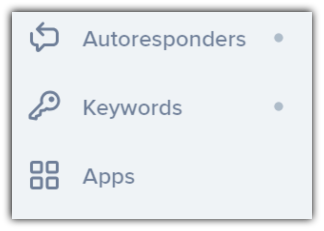
2. Choose Web Sign-Up Forms.
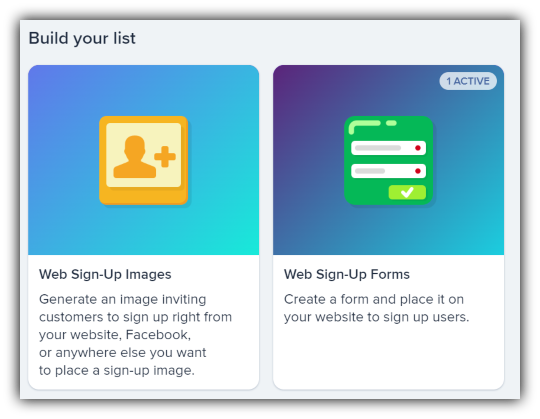
3. Decide what information you would like your site visitors to fill in.
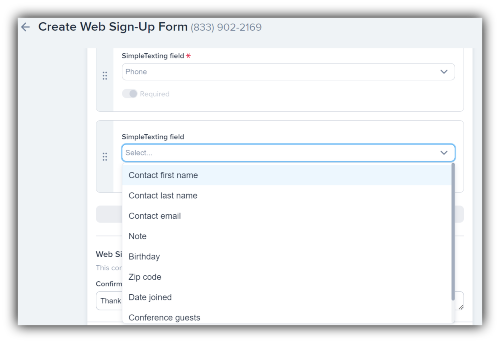
4. Save your form and copy the website code to add to your site hosting platform.
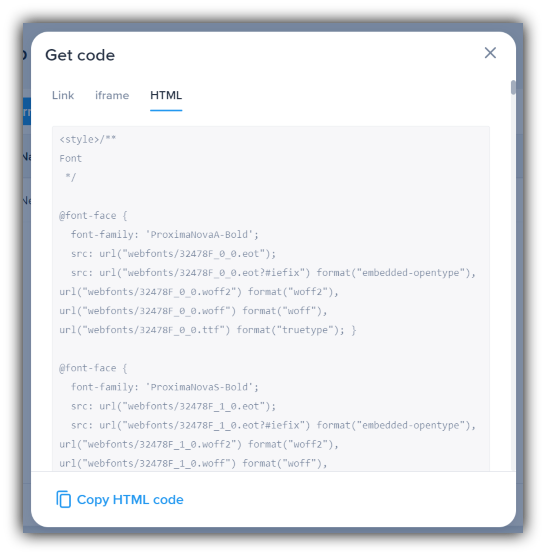
Web forms are a convenient way to bring in new text contacts while staying compliant with industry rules and regulations.
Tactic 2: Invite In-Store Customers to Join Your VIP Text Club
Your website isn’t the only place where you can capture new text subscribers.
If you run a brick-and-mortar business, you’ll want to set up a keyword.
A keyword is a short, memorable word or phrase that customers can text to your number to sign up for your text messages.
Within your space, you can advertise this keyword on your storefront, on any paperwork your customers fill out, on your business cards, or anywhere else visible.
You can set up a keyword in seconds. Here’s how it’s done:
1. Choose Keywords on the left side of your SimpleTexting dashboard.

2. Decide what your keyword will be and choose the list where new contacts who you use it will go (or create a new one).
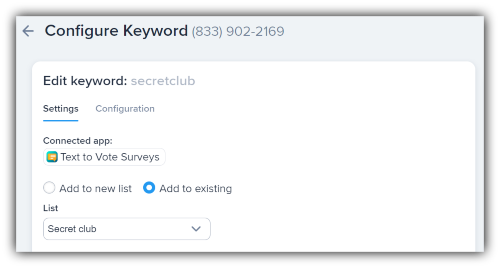
3. Set up your auto-confirmation message and adjust your compliance message if needed.
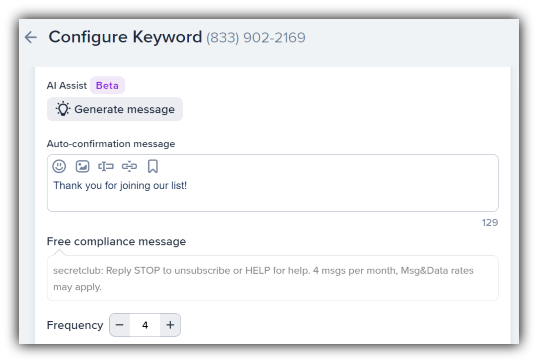
4. Choose how you’ll get notified of new subscribers (and how often).

5. Save your keyword and start advertising it.
Tactic 3: Ask Email Subscribers to Receive Texts
Have you already got a thriving email list? Tell them about your text list and encourage them to join using a keyword (or another opt-in method).
As an extra incentive, let them know that your text list will include exclusive offers or content.
Tactic 4: Welcome Social Media Followers to Enroll in Your Text Program
On a similar note, advertise your SMS list on any social media accounts you use and mention to your audience that texts are the best way to keep up with your brand.
Text Marketing Automation Strategies
Why do all the work manually? Here are a few text automation strategies you can use to streamline your SMS marketing tasks.
Tactic 5: Subscription Confirmation Text
Fast follow-ups are essential for keeping customers happy, so set up confirmation texts to go out as soon as customers confirm their subscriptions.
If customers are just subscribing to your text list, set up a welcoming auto-confirmation message or autoresponder for those who use your keyword or web form.
If customers are subscribing to your product or service, set up an integration between your existing e-commerce platform or CRM and SimpleTexting to trigger a welcome text with every new subscription.
Tactic 6: Welcome Text
Similarly, welcoming new text contacts is the best way to start your customer relationships on the right foot.
Be sure to include your brand name, what kind of texts contacts can expect to receive, how often you’ll be texting them, and how subscribers can opt out. This is also a great time to establish your brand voice and start building customer relationships.
Tactic 7: Birthday Text
Make your customers feel valued by reaching out to celebrate them even when they’re not actively patronizing your brand. Most people love to have their birthday acknowledged, so let them know you care about them as an individual with a birthday text.
You can easily schedule these texts from your SimpleTexting inbox using the clock icon next to the message box or trigger them from your CRM.
Tactic 8: Anniversary Text
The same concept applies to congratulating (and thanking) customers for sticking with your business over the year(s).
Let them know that you appreciate their business and consider throwing in a perk like a free gift or unique discount.
Tactic 9: Abandoned Cart Text
Abandoned carts don’t have to be the end of the world.
When you notice that a customer has added items to their carts but failed to check out, send them a message (this is another good moment for e-commerce integrations) reminding them to come back and snag their items.
To help motivate them, you might mention that you won’t be able to hold their items for long or offer them a coupon.
Tactic 10: Order Confirmation Text
Don’t keep your customers in suspense after they buy from you.
Set up order confirmation texts from your online store through SimpleTexting to let customers know that their purchase was successful.
You can even include tracking details or a time estimate for when they can expect their order to help them monitor the process. This will also prevent future customer service issues.
SMS Message Campaign Optimization Strategies
Successful SMS campaigns come down to more than a skillful setup. Here are a few best practices to help your campaigns perform at the highest level.
Tactic 11: Keep Text Messages Concise
SMS is, by nature, a short format (the acronym itself stands for “short message service”).
At 160 characters or even an expanded 1600 characters with MMS, you’ve only got room for the basics.
Simply let contacts know the necessary details and, if you need to give them more information, include a link to your website or content.
Tactic 12: Incentivize Activity
Sometimes prospective customers just need a slight nudge to take action. You can give them that nudge in a few ways.
- Include teasers in your message for special sales, content, or events along with a link that subscribers can click. Creating a little FOMO is an excellent way to help your audience interact with your texts.
- Send out text-exclusive coupons and codes to your contacts along with instructions for redeeming them or links to your site to incentivize them to go and browse or shop.
Tactic 13: Leverage a Sense of Urgency
On the subject of incentivizing your subscribers, consider setting up short-term sales or activities that require fast action.
Flash sales and contests are a great way to inspire some urgency. Just be sure that when you send out messages announcing limited-time events, you mention when they end and encourage contacts to get involved before time runs out.
Tactic 14: Include a Call to Action
Of course, your subscribers can’t really take action if they’re not sure what action you want them to take.
Examples of good calls to action could include:
- Click the link in this message
- Head to our website to learn more
- Watch our new video
- Call our office to book an appointment
- Reply to this text
Tactic 15: Personalize When Possible
Personalization is a must-have for any good SMS marketing program, both because 91% of consumers are more willing to buy from brands that send relevant offers and recommendations and because it will help you build better customer relationships.
Personalize your messages with any details your subscribers have shared with you, like their names, birthdays, product preferences, etc.
Tools like custom fields and customer segments are an easy way to personalize your messages with individual details and ensure that your contacts only get messages they’ll want to engage with, respectively.
Tactic 16: Send at the Best Times
Timing matters when sending messages. It doesn’t matter how amazing your text messages are if your subscribers are receiving them before their morning coffee.
Stick to business hours and the needs of your specific audience to decide when the best time to send your messages would be.
Tactic 17: Establish Your SMS Send Frequency
Consistency is key to keeping your subscribers engaged and not irritated or bored with your messages.
Let contacts know how often they can expect to hear from you in your first compliance message and stick close to that number. This looks a little different for every organization. If you’re a gym owner, you might send out one or two messages a week, whereas coaches like Minda Zetlin send out daily motivational messages like the example below.

Tactic 18: Measure, Report, and Iterate
Of course, if you want your messages to perform better and better over time, you’ll need to measure the response to each campaign you send and note what works and what doesn’t.
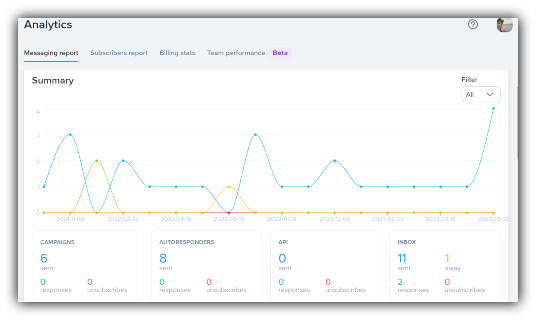
You can easily do that through SimpleTexting’s Analytics page. Keep a close eye on metrics like:
- Send success rate
- Contacts who unsubscribed
- Responses
- How many people clicked the links you sent
- Overall click-through rate (CTR)
Knowing these numbers will give you a clear idea of how to change variables around for more successful marketing messages in the future.
SMS Marketing Tactics and Strategies FAQs
What is SMS automation?
Automation saves you time and keeps your SMS marketing efficient.
What are the three types of SMS?
- Promotional – Messages that advertise a product, service, or deal and encourage the reader to buy
- Transactional – Texts that confirm or provide updates on orders or transactions
- Brand awareness/relationship building – Messages meant to spread the word about a particular brand or build stronger connections with the audience
What is SMS functionality?
What is the difference between a text message and an SMS message?
You can also send MMS messages, however, that can include media like audio or videos and up to 1600 characters. The reason that matters is that MMS messages are also frequently called “text messages.”
So, all SMS messages are text messages, but not all text messages are SMS messages.